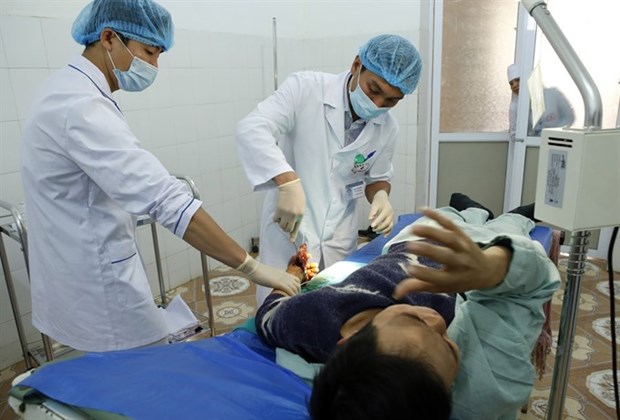 Doctors at Tam Duong district’s clinic in northern province of Lai Chau have been trained in complex techniques by those from central and provincial-level hospitals so that their patients don’t need to be transferred to higher level hospitals (Photo VNA)
Doctors at Tam Duong district’s clinic in northern province of Lai Chau have been trained in complex techniques by those from central and provincial-level hospitals so that their patients don’t need to be transferred to higher level hospitals (Photo VNA)
Hanoi (VNA) – Some 6.6 million people have received better
as a result of a project which rotates doctors from
high-level to lower-level hospitals, implemented in Vietnam since 2008.
After completing a three-month training course on diagnosing osteo-arthritis
and giving peripheral joint injections at the E General Hospital in Hanoi,
Dr Pham Thi Lien from the northern province of Lai Chau is much more confident.
Lien is now adept at combining traditional and modern medicinal disciplines at
Tam Duong district clinic’s Department of Traditional Medicine.
“We are now able to help lots of patients get treatment for musculo-skeletal
disorders,” Lien said. “We no longer have to transfer them to higher-level
hospitals, and they give us lots of compliments.”
Lien went to the E General Hospital under a project known as Project 1816 that
started in 2008.
In an effort to motivate medical graduates to help out in rural areas and take
the pressure off urban hospitals, where patients flock for treatment, the
system rotates doctors from higher-level to lower-level hospitals.
Launched by the Ministry of Health, it aims to improve health treatment at
lower-level hospitals, reduce patient overload at
higher-level hospitals; and transfer medical techniques
to lower-level hospitals through on-the-job training for medical
staff.
In 10 years of operation, about 10,000 have moved for three
months or so from higher-level to lower-level hospitals, providing far
better treatment for about 6.6 million patients.
As part of efforts to reduce patient overload at higher-level hospitals, a
medical collaboration project known as “satellite ” was launched in
2013.
Considered a part of Project 1816, the project establishes and strengthens
connections between higher-level and lower-level hospitals through training
activities, technology transfer, improvement of facilities, and upgrading of
medical equipment.
Twenty-two higher-level hospitals are participating in the project to support
117 satellite hospitals.
Taking part in the project in 2014, the Binh Dinh Traditional Medicine Hospital
in the central province of Binh Dinh became a satellite hospital of the
Central Acupuncture Hospital in Hanoi. It received medical equipment
from the Central Acupuncture Hospital for their two units: spinal pain
management and special care for people with paralysis.
The equipment has improved Binh Dinh Traditional Medicine
Hospital’s treatment quality and helped them attract more
patients, the online
newspaper baobinhdinh.com.vn reported.
The number of patients at the spinal pain management unit rose from 407 in 2014
(before the equipment transfer) to 803 in 2016, according to Dr Le Phuoc Nin,
the hospital’s director. The number of patients at the special care unit for
with paralysis rose from 418 in 2014 to 871 in 2016, he added.
“The average treatment duration has decreased from 22.2 days in 2015 to 21.2 in
the first half of 2017, reducing costs for patients,” he said.
The higher-level hospitals and their satellite hospitals are connected
through information technology (IT) systems. The use of telecommunication and
IT to provide clinical health care from a distance (telemedicine) – is
frequently applied at higher-level hospitals to conduct training, conferences,
and group consultation with their satellite hospitals.
Having focused on reducing patient overload at the departments of cardiology,
orthopaedics, obstetrics, pediatrics, and oncology at higher-level hospitals in
the 2013-16 period, the “satellite hospitals” project will do
the same for the endocrine, hematology and blood transfusion departments at
these hospitals in the 2016-20 period.-VNA
Source: VietnamPlus
